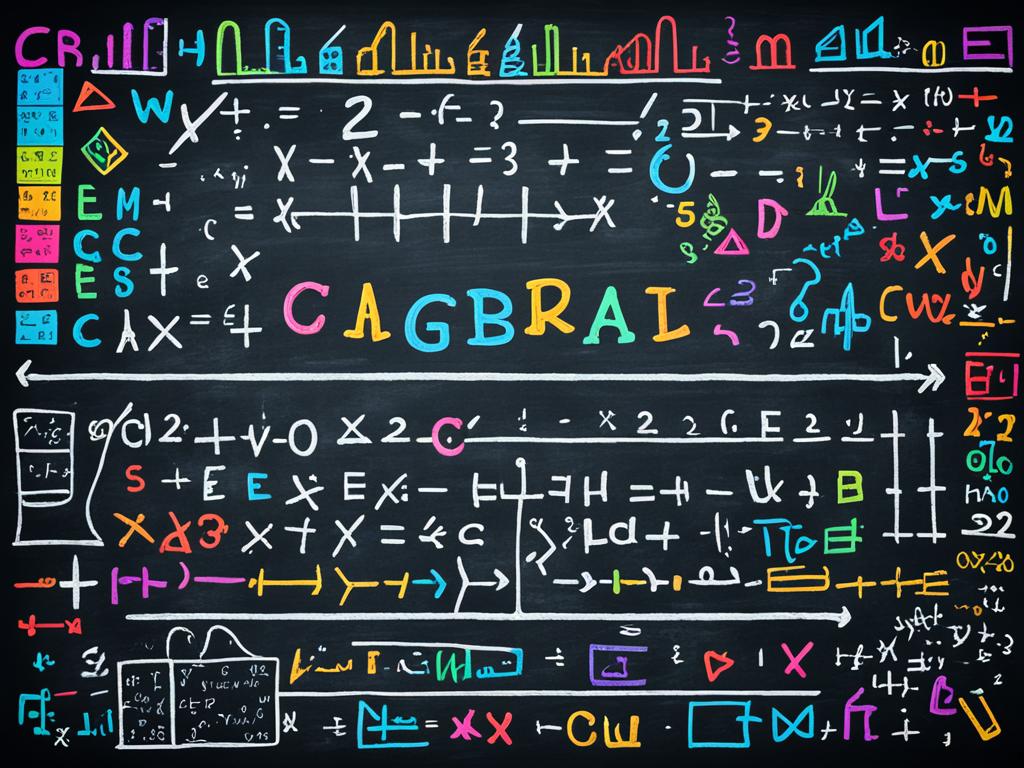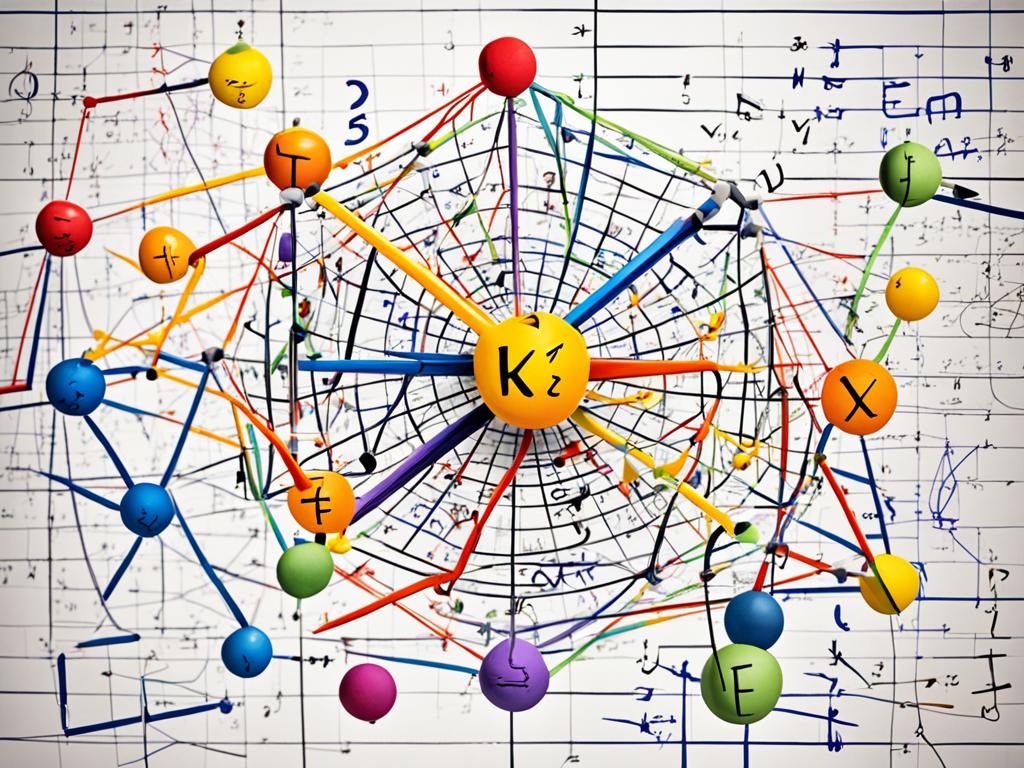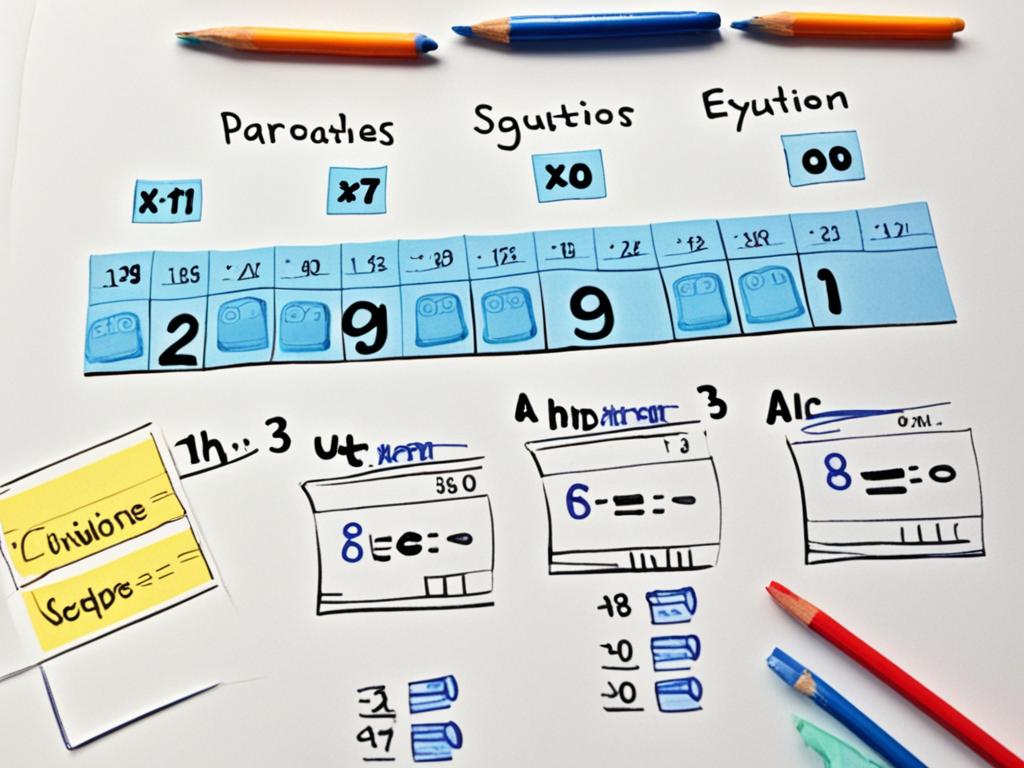
Algebra Expression: Mathematics | Learn the Basics
Algebra expressions are key to understanding mathematics. They help us see how variables, constants, and equations are connected. This article will cover the basics of algebraic expressions. We’ll look at their importance, learn about variables and constants, and explore how to solve equations.
Algebra is more than just basic math. It helps us solve complex problems and understand the world of numbers. This article is for students, researchers, or anyone interested in math. It will teach you the basics of algebra expressions.

We’ll cover everything from simple linear equations to complex quadratic expressions. By the end, you’ll know the basics of algebra well. This will let you solve different problems and explore new areas in math.
Introduction to Algebra Expressions
Algebra is a key part of math that looks at mathematical expressions, variables, and equations. At its heart, algebraic expressions are the main parts of this subject. Knowing about these expressions is key to getting good at algebra.
What are Algebraic Expressions?
Algebraic expressions are math phrases that mix variables, constants, and operations like adding, subtracting, multiplying, and dividing. They help us work with unknowns, shown by letters or symbols, in a clear way.
Expressions can be simple or complex, from basic ones with one variable to complicated polynomial ones with many variables and powers. This makes algebraic expressions useful for solving many real-world problems, like budgeting or physics.
Importance of Algebra in Mathematics
Algebra is very important in math. It connects basic math with more complex areas, helping with logical thinking and solving problems. Learning about algebraic expressions helps students get better at abstract thinking and solving math problems.
Algebra also prepares students for more advanced math like calculus, linear algebra, and abstract algebra. Being good at algebra is a must for these subjects and helps in many careers, from science to finance.

In short, algebraic expressions are key to algebra, a basic part of math. Understanding these expressions helps students build a strong base in algebra. This opens doors to more math and problem-solving.
Algebra expression: mathematics
Algebra is a key part of math that looks at algebraic expressions, equations, and their traits. These expressions are vital in many areas, like linear algebra, solving quadratic equations, calculus, and modeling math problems.
In algebra, we use letters for variables and numbers for constants. We mix these with operations like adding, subtracting, multiplying, and dividing. This creates algebraic expressions.
Types of Algebraic Equations
Algebraic expressions can turn into different types of equations, each with its own way of solving. Some common types include:
- Linear Equations: These have variables to the first power. They can be solved using the elimination or substitution method.
- Quadratic Equations: These have variables to the second power. They can be solved with factorization or the quadratic formula.
- Polynomial Equations: These have variables to various powers. They can be solved with factorization, synthetic division, or the rational root theorem.
Algebra isn’t just about solving equations. It’s also key in linear algebra, where we work with matrices and vectors. It’s also crucial in calculus, helping us model and analyze functions and rates of change.
Algebra is vital in mathematical modeling too. It helps us turn real-world problems into math equations. These models help us predict, analyze trends, and make decisions in fields like science, engineering, economics, and social sciences.
| Algebraic Concept | Description | Application |
|---|---|---|
| Linear Algebra | The study of linear equations, matrices, and vector spaces | Used in fields like computer science, physics, and engineering |
| Quadratic Equations | Equations involving variables raised to the second power | Used in optimization problems, physics, and economics |
| Calculus | The study of rates of change and the accumulation of quantities | Used in fields like physics, engineering, and economics |
| Mathematical Modeling | The process of representing real-world problems using mathematical equations | Used in fields like science, engineering, economics, and social sciences |
Algebra expressions are more than just math concepts. They are powerful tools that help us understand and model our world. From simple linear equations to complex calculus, algebra is essential in many scientific and mathematical fields.

Algebra: Understanding Variables and Constants
In algebra, variables and constants are the basics. They help us show and change mathematical relationships. Knowing about these elements is key to handling algebraic expressions and equations.
Defining Variables
Variables are symbols, often letters, that stand for unknown or changing values. They act as placeholders. We can give them different values to see how things relate in a problem. For example, in 2x + 3 = 7, x is the unknown value we’re trying to find.
Variables can look different, like:
- Single letters (e.g., x, y, z)
- Combinations of letters (e.g., ab, xyz)
- Subscripted letters (e.g., x1, x2, y_i)
The main thing about a variable is its value can change or be changed in a problem or expression.
| Variable | Constant |
|---|---|
| Represents an unknown or changing quantity | Represents a fixed, known value |
| Can be assigned different values | Cannot be changed within the context of a problem |
| Denoted by letters (e.g., x, y, z) | Represented by numbers (e.g., 3, 7, -2) |

It’s important to know about variables to work with algebraic expressions, solve equations, and understand relationships in math problems.
Operations with Algebraic Expressions
Algebraic expressions are key to math. Knowing how to work with them is vital for algebra success. We’ll look at adding, subtracting, multiplying, and dividing these expressions.
Addition and Subtraction of Algebraic Expressions
Adding or subtracting these expressions means combining like terms. These are terms with the same variables and powers. You add or subtract the numbers in front of these terms, keeping the variables the same.
- Find the like terms in the expressions.
- Add or subtract the numbers in front of the like terms.
- Keep the variables the same in the like terms.
Multiplication of Algebraic Expressions
Multiplying these expressions means multiplying each term in one with each in the other. Then, combine the terms by adding the powers and multiplying the numbers.
- Multiply each term in one expression with each in the other.
- Add the powers of the variables in the new terms.
- Multiply the numbers in the new terms.
Division of Algebraic Expressions
Dividing is the opposite of multiplying. To divide, find the inverse of the divisor and multiply the dividend by it.
- Find the inverse of the divisor expression.
- Multiply the dividend by the inverse of the divisor.
- Combine like terms and reduce powers in the result.
Getting good at working with algebraic expressions is key to algebra skills. Knowing how to add, subtract, multiply, and divide them helps you tackle harder problems and equations.

Solving Algebraic Equations
Algebra is more than just working with variables and expressions. It’s a powerful tool for solving many types of equations. We’ll explore how to solve linear and quadratic equations. These skills are key for problem-solving and modeling in math.
Algebra: Linear Equations
Linear equations are simple, with variables raised to the first power. To solve them, we aim to get the variable alone on one side. This means combining like terms, moving variables to one side, and using opposite operations to find the variable’s value.
- Combine like terms on each side of the equation.
- Move all variable terms to one side and all constants to the other.
- Use inverse operations (addition, subtraction, multiplication, or division) to isolate the variable.
- Solve for the variable and check it by putting it back into the original equation.
Algebra: Quadratic Equations
Quadratic equations are a bit tougher, with variables squared. You can solve them using factoring, completing the square, or the quadratic formula. The method you choose depends on the equation’s form.
- Factoring: If the equation can be factored, set each factor equal to zero and solve for the variable.
- Completing the Square: This method involves changing the equation into a perfect square, which is easier to solve.
- Quadratic Formula: The quadratic formula gives a general solution for any quadratic equation, no matter its form.
Learning to solve linear and quadratic equations is key in algebra and beyond. These skills help you handle a wide range of math problems. From simple word problems to complex models, you’re ready.

Conclusion
As we wrap up our look at algebra expressions, it’s clear they’re key in math. They help us understand variables and constants, and how to solve complex problems. These skills are crucial for more advanced math.
Algebra lets us show and change relationships between numbers in a simple way. It helps us solve real-world problems, analyze data, and make smart choices. This knowledge is vital in many areas, like science, engineering, finance, and economics.
In this article, we’ve looked closely at algebra’s details. We covered the basics of algebraic expressions, the importance of variables and constants, and different operations. Now, readers have the tools to tackle math with confidence and accuracy. Keep exploring algebra, face new challenges, and discover its many possibilities.
FAQ
What are algebraic expressions?
Algebraic expressions mix variables, constants, and operations like addition and division. They help us work with quantities in a flexible way.
Why is algebra important in mathematics?
Algebra is key in solving problems and modeling real-life situations. It helps us use variables, equations, and functions. This is vital in science, engineering, and finance.
What are the different types of algebraic equations?
Algebra has linear, quadratic, and higher-order polynomial equations. These are used to model many real-world situations. They’re important in fields like calculus and linear algebra.
How do you define variables and constants in algebra?
Variables in algebra stand for unknown or changing values. Constants are fixed values. Variables are letters like x, y, or z, while constants are numbers or specific values.
What are the basic operations performed on algebraic expressions?
You can add, subtract, multiply, and divide algebraic expressions. These operations are key for simplifying expressions and solving equations.
How do you solve linear and quadratic equations?
For linear equations, isolate the variable using inverse operations. Quadratic equations can be solved by factoring, completing the square, or the quadratic formula. The method depends on the equation’s form.


